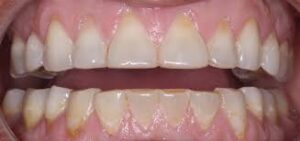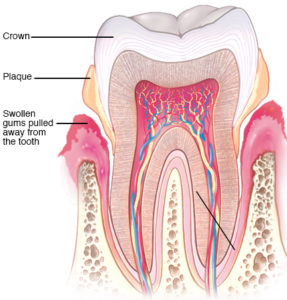Header logo
header top contact widget
Aesthetic Gum Treatment
How Straight Teeth Support Oral Health & Dental Implant Success
Posted on Apr 19, 2021 by William J. Claiborne, DDS MS
As a Periodontist, I often work in conjunction with other dental specialists to provide an optimal outcome at the direction of the patient’s general dentist. By combining our specific skills, we are able to create a complete-care integration of services tailored to attend to unique or complex needs.
For example, as a specialist in the treatment of gum disease and placement of dental implants, my skills are beneficial for ideal outcomes as well as in long-term success. This is especially true when I note signs of bite misalignment in a dental implant patient.
The ‘bite’ refers to how the top row of teeth fit to the bottom row. These upper and lower teeth should “rest” together harmoniously. This fit has a great deal to do with a balanced alignment that is far reaching.
For instance, when teeth are not in proper alignment, there is an interference in the

Teeth worn down from grinding, or “bruxing”
interaction of biting, chewing and even speaking. This misalignment can strain the jaw joints as well as the muscles of the face, extending out to neck and shoulder muscles.
Bite misalignment is a common cause of temporomandibular joint (or TMJ) disorder. The TMJ are located on each side of the head and hinge the lower jaw to the skull. Continual stress on these joints can lead to an inflammation that triggers a series of problems.
In most cases, bite misalignment is what triggers night-time clenching and grinding. Known as bruxing, this action can result in chipped, broken and fractured teeth. Other symptoms associated with a misaligned bite – and thus, TMJ problems – include frequent headaches and migraines, ear ringing, dizziness and difficulty opening the mouth fully.
As an Asheville periodontist, I also see how bite misalignment can cause the gums to recede. This occurs as misaligned teeth tilt or turn, which causes an unnatural pulling on the gum tissues surrounding the tooth at its base. As more vulnerable sections of the tooth are exposed, the risks for developing cavities and gum disease increases.
When it comes to dental implants, success rates can be greatly compromised with the presence of clenching and grinding. Here’s why…
 A dental implant is placed in the jaw bone, serving as a replacement tooth root. During the first 3 – 6 months, the bone grows around it, securing it firmly into the bone surrounding it. This process is known as osseo-integration.
A dental implant is placed in the jaw bone, serving as a replacement tooth root. During the first 3 – 6 months, the bone grows around it, securing it firmly into the bone surrounding it. This process is known as osseo-integration.
It is during this time that an implant is most vulnerable to the forces that clenching and grinding exert. When you consider that implants require up to 6 months to become fully integrated into the bone structure, the stress from grinding or clenching can disrupt this process.
According to an analysis published in Dental Implants (Oct. 2015), and using data from ten publications, bruxers experienced a 6.45 failure rate (as compared to 3.65 in non-bruxers.(https://journals.lww.com/implantdent/fulltext/2015/10000/bruxism_and_dental_implants__a_meta_analysis.5.aspx)
My involvement helps to detect what is not always apparent, yet could have a tremendous impact for a successful outcome. Working to help dental implant patients avoid problems in the future is my goal and helps to protect the patient’s investment.
Certainly, misaligned teeth that are crowded or crooked tend to bunch up together. These teeth often form tight angles, creating hard-to-reach areas that make thorough toothbrushing more difficult. As oral bacteria remain, these areas become breeding grounds for an overload of bacteria that run rampant. This can lead to the formation of cavities and the development of gum disease.
The problem of misalignment can result in a vicious cycle: (1) greater risk for gum disease; (2) higher potential for TMJ disorder; (3) increased risk for tooth loss; (4) more likelihood for dental implant failure.
Consider that periodontal (gum) disease is the nation’s leading cause of adult tooth loss. Thus, a condition such as bruxing, which can lead to gum disease, can increase the potential for tooth loss. And, in replacing teeth, bruxing can continue to compromise tooth replacement success (with dental implants or other means, such as crown-&-bridge).
If you’re considering dental implants but suspect you clench or grind your teeth, we’ll discuss ways you can achieve your smile goals and protect your investment.
Call our Asheville periodontal dental office at 828-274-9440 to schedule a consultation.
Erectile Dysfunction (ED) Risks Increase With Presence of Gum Disease
Posted on Jan 07, 2021 by William J. Claiborne, DDS MS
Men have a long way to go when it comes to taking good care of their teeth and gums, according to several surveys.
One from the Academy of General Dentistry stated that men in the U.S. are less likely to have regular dental check-ups and cleanings than women. Another survey shared by the Journal of Periodontology said men are less likely to brush regularly, and more likely to lose teeth as they age as well as develop oral cancer and gum disease.
According to the Centers for Disease Control & Prevention, over 56 percent of men have gum disease, compared to just over 38 percent of women. Men, in particular, should be aware of the increased health risks associated with periodontal (gum) disease.
Researchers have given closer assessment to recent studies and found that erectile dysfunction (ED) is more common in men with gum disease.
In addition to higher ED risks, research has found that men with a history of gum disease are 14 percent more likely to develop cancer than men with healthy gums – 49 percent more likely to develop kidney cancer, 59 percent more likely to develop pancreatic cancer and 30 percent more likely to develop a blood cancer.
If concerns about heart disease and cancers aren’t enough to get men thinking more seriously about their oral health, ED may be a condition that does.
Gum disease has emerged as an independent risk factor for cardiovascular disease, and cardiovascular disease raises the risk for ED. For men, there are a number of factors that contribute to an increased risk of cardiovascular disease. These include smoking, obesity, chronic stress, high cholesterol, high blood pressure, and chronic sleep apnea.
One study published in the Journal of Sexual Medicine revealed that men in their thirties with severe gum disease are 3 times more likely to have erection problems. As cardiovascular health issues develop, erection ability suffers, and as health problems increase in number and severity, so does the severity of ED.
The association between periodontal disease, heart disease, and erectile dysfunction relates to inflammation brought on by gum disease bacteria. This process actually comes down to a biochemical reaction. During sexual arousal, the body releases nitric oxide, which plays a key role in enabling erection. Chronic inflammations, including periodontal disease, impairs release of nitric oxide and contributes to ED.
In the U.S., an estimated 18 percent of males have erectile dysfunction. Although men who are over age 70 are more likely to have ED, males most affected by ED are getting younger. One outpatient clinic showed that 1 in 4 men who sought help for erectile dysfunction were under the age of 40.
Could maintaining a healthy mouth lower the risk of ED? In a 2013 study, it was found that treating periodontal disease improves ED symptoms. Thus, a growing number of physicians are advising male patients who have both ED and periodontitis to seek periodontal treatment as a way to reduce its risk.
In data analyzed from five studies published between 2009 – 2014 (which included 213,000 male participants between ages 20 – 80), men who had chronic periodontitis (advanced gum disease) were more likely to have erectile dysfunction.
In another study, nearly half of the men with ED also had diabetes, another chronic inflammatory disease with links to periodontal disease. Chronic inflammation in the body can be lowered when gum health is kept in good condition.
Men can help to protect their overall health by keeping their oral health at an excellent level. It is especially important to watch for signs of gum disease. Symptoms include: puffy, red gums; inflamed, swollen, or bleeding gums; gums that recede from the base of teeth; and persistent bad breath.
If you are experiencing any of these symptoms, call our Asheville periodontal dental office for an examination as soon as possible. Gum disease does not improve without treatment.
Although many serious health problems are linked to the potent bacteria of gum disease, it is one of the most preventable of all diseases. Twice daily brushing, daily flossing, a diet limited in sugar and carbohydrates and drinking plenty of water are simple guidelines to follow.
Even with these easy steps that take mere minutes per day, it is estimated that over 47 percent of American adults have some level of gum disease.
For the good of your overall health and well-being, renew your commitment to a healthy smile for the new year. Begin with a thorough examination. (A referral is not required.) We’ll discuss how to get your oral health in good shape and ways to maintain it between dental check-ups.
Call 828-274-9440 to schedule or ask to begin with a consultation. If dental anxiety or fear has kept you from regular dental care, mention this during your appointment. This is a common problem for both men and women. If desired, we offer a number of comfort options, including Oral Sedation or I.V. Sedation (twilight sleep).
Are YOU One Who Is More Likely To Have Gum Disease?
Posted on Dec 10, 2020 by William J. Claiborne, DDS MS
As a periodontist, I have a pretty unique view of the inside of a mouth.
In my specialty, we are particularly focused on the condition of the gum tissues in the mouth, or “periodontal” tissues. We are specially trained to treat all stages of gum disease and in the diagnosis and placement of dental implants.
A periodontal specialist is also trained in performing esthetic procedures that involve gum tissues, such as crown lengthening and correcting a “gummy smile”.
To clarify, a periodontist is a dentist who extends his or her education and skills further (typically 3 years past completing dental school) to specialize in the prevention, diagnosis, and treatment of periodontal disease and other gum conditions.
1). THE NATURAL AGING PROCESS
Although we treat patients of all ages, there are certain segments of the population we see more often. For instance, a large segment of our patients are age 50 and older. In addition to having more susceptibility to have gum disease, many in this age group have lost teeth.
In a recent report by the Centers for Disease Control & Prevention (CDC) on data related to prevalence of periodontitis in the U.S.: over 47% of adults ages 30 years and older have some form of periodontal disease. For adults 65 years and older, that number rises to over 70%.
This is because the aging process causes the body begins to succumb to wear and tear. The skin sags, bones weaken, joints ache, hearing dulls, and eyesight wanes. This means that more precautions and measures are needed to keep the teeth and gum tissues in good shape.
In addition to healthy gums, it’s important to keep your natural teeth as you age. Natural teeth to support neighboring teeth and provide stimulation to the jaw bone is unsurpassed.
Having the ability to comfortably and efficiently bite and chew is vital to having a healthy body. When dentures or partials compromise the ability to eat a diet of healthy foods – and chew food properly – gastrointestinal problems are common.
Although dental implants are excellent replacements for missing teeth, there is nothing as perfect as your “permanent” teeth.
There are a number of reasons why seniors face more oral challenges, including:
• A dry mouth: The tissues inside the mouth need to be kept moist. Saliva is designed to do this. However, with age, the flow of saliva becomes less plentiful. Just as the skin and hair get drier with age, the mouth undergoes this as well. When saliva flow is less efficient at rinsing bacteria from the oral cavity, bacteria grow at a more rapid rate. This allows bacteria accumulation to occur more frequently than twice-a-day brushing can control.
• Reduced ability to maintain at-home oral hygiene: Aging causes the fingers to be less nimble and stiffens joints. This is a particular challenge when it comes to brushing and flossing. Angling a toothbrush to reach all areas in the mouth and proper flossing maneuvers require manual dexterity that are more difficult due to the natural aging process.
• Medication side effects: The average American adult in the 65-79 age group has over 27 prescriptions filled each year. (https://www.statista.com/statistics/315476/prescriptions-in-us-per-capita-by-age-group/). Although you may need these medications, keep in mind that some can be detrimental to your oral health. This is why it’s important to provide a complete list of all medications you take (including vitamins and herbal supplements) at every dental appointment so your dentist can adjust care to your specific needs.
• Hormonal changes: Due to declining estrogen levels, post menopausal females have a higher risk for gum disease and subsequent tooth loss. This causes an increased risk of bone loss or osteoporosis as well as inflamed gum tissues around the teeth (called periodontitis). When there is a decline in jaw bone mass, it can result in tooth loss.
Bacteria overgrowth in the mouth is the cause of gum disease. Periodontal disease is the nation’s leading cause of adult tooth loss. Its bacteria can also enter the bloodstream, causing inflammatory reactions far beyond the mouth.
Advanced gum disease bacteria has been linked to a number of serious health problems. These include heart disease, stroke, high blood pressure, diabetes, arthritis, memory loss, some cancers, impotency and Alzheimer’s disease.
Obviously, maintaining healthy gums and keeping your natural teeth is important. If you’ve experienced tooth loss, we can replace them with dental implants. These are the closest thing to the natural teeth you had and will restore stability and dependable biting and chewing.
At any age, the goal is to keep bacteria levels in the mouth to the lowest level possible. When oral bacteria are allowed to accumulate, it can lead to Gingivitis. This is an early stage of gum disease. As it progresses, periodontal disease continually worsens. Eventually, it becomes periodontitis, which is an advanced level of gum disease.
Although gum disease can exist without obvious signs or symptoms, the most commonly noticed are:
• Red, swollen or tender gums
• Seeing blood in the sink when brushing
• Receded gums • Loose or separating teeth
• Pus pockets on gum tissues
• Sores in the mouth
• Persistent bad breath
2). ADULTS WITH DENTAL FEAR
Another large segment of our patients are those who have avoided dental care for years, often due to having dental fear.
One study, published by StudyFinds.org, shares recent findings of 2,000 adults in the U.S. regarding dental visits. Results show a whopping 62% of those surveyed stating they were too afraid to even visit a dentist’s office. (https://www.studyfinds.org/adults-too-scared-visit-dentist-teeth/)
If dental fears or anxiety have kept you from regular dental checkups for a year or more, it would be rare to NOT have some level of gum disease. Quite frankly, some people with high fear levels avoid seeing a dentist for decades. Those visits are vital in one’s ability to have healthy gums.
While twice daily brushing and daily flossing are necessary components for having good oral health, the routine alone isn’t enough to combat a number of additional factors that make one vulnerable to the disease.
For example, a study by Delta Dental revealed, only 7 out of 10 adults are brushing twice a day. This means that 30% aren’t brushing enough. (https://www.ada.org/en/publications/ada-news/2014-archive/october/survey-finds-shortcomings-in-oral-health-habits)
3). PREGNANCY
We also see a number of moms-to-be. For decades, the Surgeon General has warned that pregnant females who had gum disease had a far greater risk of a pre-term, low birth weight baby. Research has shown that gum disease increases the risk for pre-term delivery (prior to 37 weeks) and low birth weight babies (less than 5.5 lbs.).
“Studies have found that expectant mothers with periodontal disease are up to seven times more likely to deliver premature, low birth weight babies.” (https://www.adha.org/resources-docs/7228_Oral_Health_Total.pdf) One study showed the preterm birth rate for pregnant women with moderate to severe periodontal disease to be nearly 29%.
Estimates are that over half of pregnant women have some form of gingivitis (gum inflammation, an early stage of gum disease) or periodontitis (infectious, advanced gum disease). Nearly a third of pregnant females will acquire gum disease because of their higher vulnerability to inflammation.
When these indications exist, it is important to seek periodontal treatment as soon as possible. Gum disease only worsens without treatment, requiring more time and expense to rid this serious, even deadly, inflammatory disease.
4). ALL ADULTS
Regardless of age or health status, oral wellness has always been important to overall health. Without good gum health, there is a greater drain on the body’s immune system. This is now even more important than ever, due to COVID and the flu season upon us.
Remember, even a twice-daily brusher and daily flosser does not mean you will avoid gum disease. Avoiding regular dental check-ups is a sure recipe for needing treatment down the road that may have easily been prevented.
In our Asheville periodontal dental office, patients can begin with a consult in our private consultation room that’s removed from the clinical side of the practice. We are always happy to discuss oral health options with new patients. A referral is not needed.
Call 828-274-9440 to schedule.
How To Avoid Gum Disease & Cavities From Sugar This Holiday
Posted on Nov 12, 2020 by William J. Claiborne, DDS MS
Regardless of size and distancing limitations on 2020 holiday gatherings, you can bet that Americans will still consume the yummy indulgences associated with the season. After all, we all need comfort food these days. The holidays simply give us “justification” for eating the sugary, rich treats we’ve waited all year to enjoy. We release the guilt and know we’ll pay for it through our new year’s resolutions.
I’m the last person on earth who would preach abstinence when it comes to things like thick egg nog, sugar cookies and pecan pie. Like you, I wait all year to savor things like this. However, I’m also a periodontist and have a unique look at what this added sugar can do to teeth and gums.
Keep in mind that all food (as well as beverages other than plain water) cause an acidic surge into the mouth. This is sent in via saliva and is the first stage of the digestive process. This acid is so strong it can actually soften tooth enamel for 20-30 minutes, leaving you with a higher risk for tooth decay.
Sugar also super-charges oral bacteria, which are living, eating and breeding organisms. They thrive in colonies as they subsist on gum tissues. As bacteria levels grow, the gums become inflamed. This is the first stage of periodontal (gum) disease.
As gum disease worsens, the inflammation caused by these bacteria can lead to persistent bad breath, receded gums that expose sensitive tooth roots, and gums that darken in color. If untreated, pus pockets can eventually form at the base of some teeth and attack the tooth supporting structures beneath the gums.
Eventually, teeth will loosen and can require removal. Also known as periodontal disease, this is the nation’s leading cause of adult tooth loss.
Even without the holidays, Americans are the biggest sugar consumers on earth. Although the World Health Organization (WHO) recommends no more than 5% of daily sugar intake, or less than 25 grams, Americans consume 82 grams each day, on average. That translates into over 19 teaspoons of sugar per day and 66 pounds each year, per person.
When researchers from the University College London & London School of Hygiene studied public health records from around the world, they found that 92% of American adults have cavities. Compare this to Nigeria, a country with a diet very low in sugar, where only 2% of the population have had tooth decay. Also concerning were their findings that nearly 90% of America’s school age children have experienced tooth decay.
Childhood obesity is also out of control. The Centers For Disease Control & Prevention (CDC) reports that the U.S. percentage of children with obesity “has more than tripled since the 1970s. Today, about one in five school-aged children (ages 6–19) has obesity.” That’s nearly one-third of children who are overweight or obese. https://www.cdc.gov/healthyschools/obesity/facts.htm Obesity is when fat content of the body is over thirty percent of its overall mass.
According to the Centers For Disease Control & Prevention (CDC), adults in the U.S. who are categorized as obese is at nearly 40 percent. Another 30 percent are categorized at overweight.
While sugar is not the only culprit, Americans have been lured into a lifestyle surrounded by sugary snacks and beverages. (After all, ads tell us that we need to grab a Snickers bar, not an apple, as an afternoon pick-me-up.)
You may be surprised to know that studies show that sugar is even addictive. It activates the same regions in the brain that react to cocaine. (https://www.brainmdhealth.com/blog/what-do-sugar-and-cocaine-have-in-common/)
How does this apply to your smile? Research has shown that obese adults have a 6 times higher potential to develop periodontal (gum) disease. As a periodontal specialist, my goal is always to help patients achieve optimal oral health. In our Asheville periodontal dental office, we address the risks of periodontal disease with our patients without judgement of their weight, but rather how we can help them enjoy a healthier smile.
As difficult as losing weight can be, it is important to be aware of risk factors that can make you more susceptible to gum disease. Initial symptoms include gums that are tender, swollen, and may bleed when brushing. This stage, known as gingivitis, is actually reversible with prompt, thorough oral hygiene.
This holiday, try to reduce your intake of sugar and carbohydrates. This will help to lower your potential for damage by oral bacteria, reducing your risk for cavities and gum disease. Additionally, be committed to a thorough at-home routine of daily flossing, twice a day brushing and drinking plenty of water.
If you are experiencing symptoms of gum disease, however, it is important to be seen by a periodontist as soon as possible to halt further progression. A periodontist is a dental specialist who has advanced training in treating all stages of gum disease as well as in the placement of dental implants. The earlier the treatment, the less involved treatment requirements will be. Gum disease will not improve without professional care.
Call 828-274-9440 to schedule an initial examination or begin with a consultation.
Recent Posts
Categories
Archives
- September 2024
- August 2024
- July 2024
- June 2024
- May 2024
- April 2024
- March 2024
- February 2024
- January 2024
- December 2023
- November 2023
- October 2023
- September 2023
- August 2023
- July 2023
- June 2023
- May 2023
- April 2023
- March 2023
- February 2023
- January 2023
- December 2022
- November 2022
- October 2022
- September 2022
- August 2022
- July 2022
- June 2022
- May 2022
- April 2022
- March 2022
- February 2022
- January 2022
- December 2021
- November 2021
- October 2021
- September 2021
- August 2021
- July 2021
- June 2021
- May 2021
- April 2021
- March 2021
- February 2021
- January 2021
- December 2020
- November 2020
- October 2020
- September 2020
- August 2020
- July 2020
- June 2020
- May 2020
- April 2020
- March 2020
- February 2020
- January 2020
- December 2019
- November 2019
- October 2019
- September 2019
- August 2019
- July 2019
- June 2019
- May 2019
- April 2019
- March 2019
- February 2019
- January 2019
- December 2018
- November 2018
- October 2018
- September 2018
- August 2018
- July 2018
- June 2018
- May 2018
- April 2018
- March 2018
- February 2018
- January 2018
- December 2017
- November 2017
- October 2017
- September 2017
- August 2017
- July 2017
- June 2017
- May 2017
- April 2017
- March 2017
- February 2017
- January 2017
- December 2016
- November 2016
- October 2016
- September 2016
- August 2016
- July 2016
- June 2016
- May 2016
- April 2016
- March 2016
- February 2016
- January 2016
- December 2015
- November 2015
- October 2015
- September 2015
- August 2015
- July 2015
- June 2015
- May 2015
- April 2015
- March 2015
- February 2015
- January 2015
- December 2014
- November 2014
- October 2014
- September 2014
- August 2014
- July 2014
- June 2014
- May 2014
- April 2014
- March 2014
- February 2014
- January 2014
- December 2013
- November 2013
- October 2013
- September 2013
- August 2013
- July 2013
- June 2013
- May 2013
- April 2013
- March 2013
- February 2013
- January 2013
- December 2012
- November 2012
- October 2012
- September 2012
- August 2012
- July 2012
- June 2012


